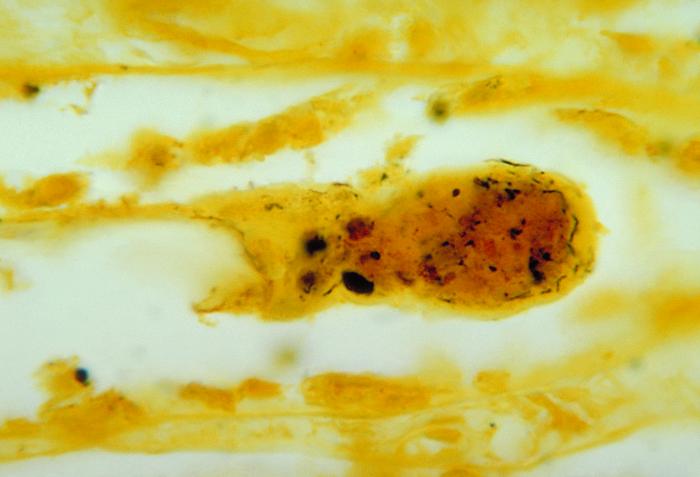Leptospirosis laboratory findings: Difference between revisions
No edit summary |
No edit summary |
||
| Line 11: | Line 11: | ||
Leptospira can be cultured in Ellinghausen-McCullough-Johnson-Harris medium, which is incubated at 28 to 30ºC.<ref>{{cite journal|title=Gellan gum as a substitute for agar in leptospiral media|author=Rule PL, Alexander AD|journal=J Clin Microbiol|volum=23|issue=3|pages=500–504|year=1986|pmid=3754265}}</ref> The median time to positivity is three weeks with a maximum of 3 months. This makes culture techniques useless for diagnostic purposes, but is commonly used in research. | Leptospira can be cultured in Ellinghausen-McCullough-Johnson-Harris medium, which is incubated at 28 to 30ºC.<ref>{{cite journal|title=Gellan gum as a substitute for agar in leptospiral media|author=Rule PL, Alexander AD|journal=J Clin Microbiol|volum=23|issue=3|pages=500–504|year=1986|pmid=3754265}}</ref> The median time to positivity is three weeks with a maximum of 3 months. This makes culture techniques useless for diagnostic purposes, but is commonly used in research. | ||
===Laboratory Findings=== | ===Laboratory Findings=== | ||
As the clinical manifestations of the disease are non specific, the clinical diagnosis is difficult. The laboratory investigations for leptospirosis should be considered in patient with an abrupt onset of fever, chills, conjunctival suffusion, headache, myalgia and jaundice with history of occupational exposure to infected animals or contaminated with animal urine.<ref>{{cite book | last = LastName | first = FirstName | title = Human leptospirosis : guidance for diagnosis, surveillance and control | publisher = World Health Organization | location = Geneva | year = 2003 | isbn = 9241545895 }}</ref> | As the clinical manifestations of the disease are non specific, the clinical diagnosis is difficult. The laboratory investigations for leptospirosis should be considered in patient with an abrupt onset of fever, chills, conjunctival suffusion, headache, myalgia and jaundice with history of occupational exposure to infected animals or contaminated with animal urine.<ref>{{cite book | last = LastName | first = FirstName | title = Human leptospirosis : guidance for diagnosis, surveillance and control | publisher = World Health Organization | location = Geneva | year = 2003 | isbn = 9241545895 }}</ref> | ||
Revision as of 20:01, 28 February 2017
|
Leptospirosis Microchapters |
|
Diagnosis |
|---|
|
Treatment |
|
Case Studies |
|
Leptospirosis laboratory findings On the Web |
|
American Roentgen Ray Society Images of Leptospirosis laboratory findings |
|
Risk calculators and risk factors for Leptospirosis laboratory findings |
Editor-In-Chief: C. Michael Gibson, M.S., M.D. [1]
Laboratory findings

On infection the microorganism can be found in blood for the first 7 to 10 days (invoking serologically identifiable reactions) and then moving to the kidneys. After 7 to 10 days the microorganism can be found in fresh urine. Hence, early diagnostic efforts include testing a serum or blood sample serologically with a panel of different strains. It is also possible to culture the microorganism from blood, serum, fresh urine and possibly fresh kidney biopsy. Kidney function tests (Blood Urea Nitrogen and creatinine) as well as blood tests for liver functions are performed. The later reveal a moderate elevation of transaminases. Brief elevations of aspartate aminotransferase (AST), alanine aminotransferase (ALT), and gamma-glutamyltransferase (GGT) levels are relatively mild. These levels may be normal, even in children with jaundice. Diagnosis of leptospirosis is confirmed with tests such as Enzyme-Linked Immunosorbent Assay (ELISA) and PCR. Serological testing, the MAT (microscopic agglutination test), is considered the gold standard in diagnosing leptospirosis. As a large panel of different leptospira need to be subcultured frequently, which is both laborious and expensive, it is underused, mainly in developing countries.
Leptospira can be cultured in Ellinghausen-McCullough-Johnson-Harris medium, which is incubated at 28 to 30ºC.[1] The median time to positivity is three weeks with a maximum of 3 months. This makes culture techniques useless for diagnostic purposes, but is commonly used in research.
Laboratory Findings
As the clinical manifestations of the disease are non specific, the clinical diagnosis is difficult. The laboratory investigations for leptospirosis should be considered in patient with an abrupt onset of fever, chills, conjunctival suffusion, headache, myalgia and jaundice with history of occupational exposure to infected animals or contaminated with animal urine.[2] Laboratory investigations useful in the diagnosis of leptospirosis include:
- Identification of leptospires in tissues using antibodies labelled with fluorescent markers
- Antibody detection by serological studies
- Culture the bacteria from blood, urine or tissues
- Other methods such as PCR, Immunostaining etc.
References
- ↑ Rule PL, Alexander AD (1986). "Gellan gum as a substitute for agar in leptospiral media". J Clin Microbiol (3): 500&ndash, 504. PMID 3754265. Unknown parameter
|volum=ignored (help) - ↑ LastName, FirstName (2003). Human leptospirosis : guidance for diagnosis, surveillance and control. Geneva: World Health Organization. ISBN 9241545895.